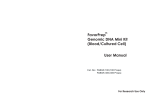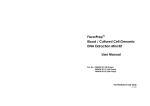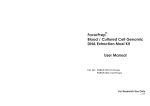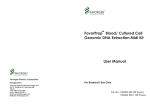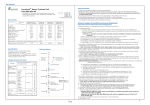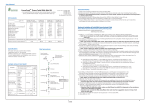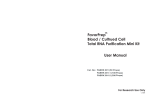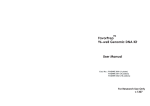Download User Manual FavorPrep Genomic DNA Mini Kit (Blood/Cultured Cell)
Transcript
TM FavorPrep Genomic DNA Mini Kit (Blood/Cultured Cell) User Manual Cat. No.: FABGK 100 (100 Preps) FABGK 300 (300 Preps) For Research Use Only Kit Contents Cultured Cell Protocol: FABGK 100 (100 Preps) FABGK 300 (300 Preps) 135 ml 30 ml 405 ml 75 ml FABG Buffer 40 ml 100 ml W1 Buffer 45 ml 130 ml Wash Buffer** (concentrated) 25 ml 50 ml Elution Buffer 30 ml 75 ml FABG Column 100 pcs 300 pcs 2 ml Collection Tube 200 pcs 600 pcs Cat. No. / preps RBC Lysis Buffer FATG Buffer **Add 100 ml / 200 ml of ethanol (96~100%) to Wash Buffer when first open. Sample Preparation For Cultured Cells: i. Trypsinize the adherent cells before harvesting. ii. Transfer the appropriate number of cell (up to 1 x 107) to a 1.5ml microcentrifuge tube (not provided) and centrifuge at 6000 x g for 20 seconds. iii. Remove the supernatant and resuspend the cells with 150 μl of RBC Lysis Buffer. For Fresh blood (except human blood): i. The sample volume of mammalian blood (non-nucleated) can be up to 50μl; the sample volume of nucleated erythrocytes (eg. bird or fish) can be up to 10μl. ii. Add 150 μl of FATG Buffer and the blood sample into a 1.5ml microcentrifuge tube (not provided), then mix by vortex. Step 1 –Cell Lysis 1. Add 200 μl of FABG Buffer and mix by vortex for 5 seconds. 2. Incubate for 10 minutes at 70ºC or until the sample lysate is clear. During incubation, invert the tube every 3 minutes. 3. Briefly spin the tube to remove drops from the inside of the lid. 4. Preheat Elution Buffer (200 μl per sample) in a 70ºC water bath. (for Step 4 DNA Elution). 5. (Optional Step): If RNA-free genomic DNA is required, add 5μl of 10 mg/ml RNase A to the sample and vortex, then incubate for 5 minutes at room temperature. 6. Follow the Fresh Blood Protocol starting from Step 3 (Binding). Cultured Cell Protocol: Sample Preparation i. Harvest appropriate number of cell (up to 5 x 107) to a 1.5ml microcentrifuge tube (not provided) and centrifuge at 5000 x g for 10 minute, then discard the supernatant. ii. Add 600 μl of sorbitol buffer (1.2 M sorbitol; 10 mM CaCl2; 0.1 M Tris-HCl pH 7.5; 35mM mercaptoethanol) and resuspend the pellet. iii. Add 200 U of lyticase or zymolase. Incubate for 30 minutes at 30ºC. iv. Centrifuge the mixture at 2,000 x g for 10 minutes to harvest the spheroplast. v. Remove the supernatant and add 200 μl of FATG Buffer to the tube and resuspend the cell pellet by vortex. vi. Incubate at room temperature for 5 minutes. vii. Follow the Cultured Cell Protocol starting from Step 1 (Cell Lysis). 1 6 Fresh Blood Protocol: Buffy Coat Protocol: Step 4 – Washing 15. Immediately, Wash FABG Column with 400μl W1 Buffer (ethanol added) by centrifuge for 1 minute then discard the flow-through. .Make sure that ethanol has been added into W1 Buffer when first open. 16. Wash FABG Column with 600μl Wash Buffer (ethanol added) by centrifuge for 1 minute then discard the flow-through. .Make sure that ethanol has been added into Wash Buffer when first open. 17. Centrifuge for an additional 3 min to dry the column. .Important Step! This step will avoid the residual liquid to inhibit subsequent enzymatic reactions. • Step 1 – RBC Lysis 1. Collect fresh human blood in an anticoagulant-treat collection tube. 2. Transfer up to 300μl fresh blood to a microcentrifuge tube (not provided). If the blood sample is more than 300 μl (up to 1 ml), add the sample to a sterile 15 ml centrifuge tube. 3. Add 3 x the sample volume of RBC Lysis Buffer and mix by inversion. Do not vortex. 4. Incubate at room temperature for 10 minutes. 5. Centrifuge at 3000 x g for 5 minutes and completely remove the supernatant. 6. Resuspend the pellet with 100 μl of RBC Lysis Buffer. Step 5 – Elution 18. Place FABG Column to a new 1.5ml microcentrifuge tube. 19. Add 100μl of Preheated Elution Buffer or TE to the membrane center of FABG Column. Stand FAGB Column for 3~5 min or until the buffer is absorbed by the membrane. .Important Step! For effective elution, make sure that the elution solution is dispensed onto the membrane center and absorbed completely. 20. Incubate the FAGB Column at 37ºC for 10 minutes in an incubator. 21. Centrifuge for 1 minute to elute the DNA . .Standard volume for elution is 100 μl. If sample has low number of cells, reduce the elution volume (30 μl - 50 μl) to increase DNA concentration. If higher DNA yield is required, repeat the DNA Elution step to increase DNA recovery and the total volume could be 200 μl. Step 2 – Cell Lysis 7. Add 200 μl of FABG Buffer and mix by vortex. 8. Incubate for 10 minutes at room temperature or until the sample lysate is clear. During incubation, invert the tube every 3 minutes. 9. Briefly spin the tube to remove drops from the inside of the lid. 10. Preheat Elution Buffer (200 μl per sample) in a 70ºC water bath (for Step 5 DNA Elution). 11. (Optional Step): If RNA-free genomic DNA is required, add 5μl of 10 mg/ml RNase A to the sample and vortex, then incubate for 5 minutes at room temperature. Step Final - Pure DNA 22. Store the DNA fragment at 4ºC or -20ºC. Step 3 – Binding 12. Add 200μl ethanol (96~100%) to the sample. Mix thoroughly by pulsevortexing for 10 seconds. (Pipetting if there is any precipitate.) 13. Briefly spin the tube to remove drops from the inside of the lid. 14. Place a FABG Column to a collection tube. Transfer the sample mixture (including any precipitate) carefully to FABG Column. Centrifuge for 5 minute and discard the flow-through then place FABG Column to a new Collection tube. Step 4 – Washing 15. Immediately, Wash FABG Column with 400μl W1 Buffer (ethanol added) by centrifuge for 30 seconds then discard the flow-through. .Make sure that ethanol has been added into W1 Buffer when first open. 16. Wash FABG Column with 600μl Wash Buffer (ethanol added) by centrifuge for 30 seconds then discard the flow-through. .Make sure that ethanol has been added into Wash Buffer when first open. 17. Centrifuge for an additional 3 min to dry the column. .Important Step! This step will avoid the residual liquid to inhibit subsequent enzymatic reactions. 5 2 Fresh Blood Protocol Buffy Coat Protocol: Step 5 – Elution 18. Place FABG Column to a new 1.5ml microcentrifuge tube. 19. Add 100μl of Preheated Elution Buffer or TE to the membrane center of FABG Column. Stand FAGB Column for 3~5 min or until the buffer is absorbed by the membrane. .Important Step! For effective elution, make sure that the elution solution is dispensed onto the membrane center and absorbed completely. 20. Centrifuge for 30 seconds to elute the DNA . .Standard volume for elution is 100 μl. If sample has low number of cells, reduce the elution volume (30 μl - 50 μl) to increase DNA concentration. If higher DNA yield is required, repeat the DNA Elution step to increase DNA recovery and the total volume could be 200 μl. Step Final - Pure DNA 21. Store the DNA fragment at 4ºC or -20ºC. Frozen Blood Protocol: Sample Preparation 1. Transfer up to 200μl sample to a microcentrifuge tube (not provided). If the sample volume is less than 200μl, add the appropriate volume of PBS. 2. Add 30μl Proteinase K (10 mg/ml) to the sample. Mix thoroughly by pulse-vortexing. Incubate for 15 minutes at 60ºC. Step 1 –Cell Lysis 3. Add 200μl FABG Buffer to the sample. Mix thoroughly by pulse-vortexing. 4. Incubate at 70ºC for 15 minutes to lyse the sample. During incubation, invert the sample every 3~5 minutes. 5. Briefly spin the tube to remove drops from the inside of the lid. 6. Preheat Elution Buffer (200 μl per sample) in a 70ºC water bath (for Step 4 DNA Elution). 7. (Optional Step): If RNA-free genomic DNA is required, add 5μl of 10 mg/ml RNase A to the sample and vortex, then incubate for 5 minutes at room temperature. 8. Follow the Fresh Blood Protocol starting from Step 3 (Binding). 3 Sample Preparation Centrifuge whole blood at 3,300xg for 10 minutes at room temperature and you will get three different fractions: the upper clear layer is plasma; the intermediate layer is buffy coat, containing concentrated leukocytes; the bottom layer contains concentrated erythrocytes. Extraction total DNA from buffy coat will yield 5-10 times more DNA than an equivalent volume of whole blood. Step 1 – RBC Lysis 1. Transfer up to 200μl buffy coat to a microcentrifuge tube (not provided). 2. Add 3 x the sample volume of RBC Lysis Buffer and mix by inversion. 3. Incubate at room temperature for 10 minutes. During incubation, invert the tube every 3 minutes. 4. Centrifuge for 1 minutes at full speed (14,000 rpm or 10,000 x g) and completely remove the supernatant. 5. Resuspend the pellet with 500 μl of RBC Lysis Buffer, then centrifuge for 1 minutes and completely remove the supernatant. 6. Resuspend the pellet with 200 μl of RBC Lysis Buffer. (Mix the tube by vortex only. Be sure the pellet is completely resuspended or the column would be barred when binding.) Step 2 – Cell Lysis 7. Add 250 μl of FABG Buffer and mix by vortex. 8. Incubate for 30 minutes at room temperature or until the sample lysate is clear. During incubation, invert the tube every 3 minutes. 9. Briefly spin the tube to remove drops from the inside of the lid. 10. Preheat Elution Buffer (200 μl per sample) in a 70ºC water bath (for Step 5 DNA Elution). 11. (Optional Step): If RNA-free genomic DNA is required, add 5μl of 10 mg/ml RNase A to the sample and vortex, then incubate for 5 minutes at room temperature. Step 3 – Binding 12. Add 250μl ethanol (96~100%) to the sample. Mix thoroughly by pulse-vortexing for 10 seconds. (Pipetting if there is any precipitate.) 13. Briefly spin the tube to remove drops from the inside of the lid. 14. Place a FABG Column to a collection tube. Transfer the sample mixture (including any precipitate) carefully to FABG Column. Centrifuge for 5 minute and discard the flow-through then place FABG Column to a new Collection tube. 4 Fresh Blood Protocol Buffy Coat Protocol: Step 5 – Elution 18. Place FABG Column to a new 1.5ml microcentrifuge tube. 19. Add 100μl of Preheated Elution Buffer or TE to the membrane center of FABG Column. Stand FAGB Column for 3~5 min or until the buffer is absorbed by the membrane. .Important Step! For effective elution, make sure that the elution solution is dispensed onto the membrane center and absorbed completely. 20. Centrifuge for 30 seconds to elute the DNA . .Standard volume for elution is 100 μl. If sample has low number of cells, reduce the elution volume (30 μl - 50 μl) to increase DNA concentration. If higher DNA yield is required, repeat the DNA Elution step to increase DNA recovery and the total volume could be 200 μl. Step Final - Pure DNA 21. Store the DNA fragment at 4ºC or -20ºC. Frozen Blood Protocol: Sample Preparation 1. Transfer up to 200μl sample to a microcentrifuge tube (not provided). If the sample volume is less than 200μl, add the appropriate volume of PBS. 2. Add 30μl Proteinase K (10 mg/ml) to the sample. Mix thoroughly by pulse-vortexing. Incubate for 15 minutes at 60ºC. Step 1 –Cell Lysis 3. Add 200μl FABG Buffer to the sample. Mix thoroughly by pulse-vortexing. 4. Incubate at 70ºC for 15 minutes to lyse the sample. During incubation, invert the sample every 3~5 minutes. 5. Briefly spin the tube to remove drops from the inside of the lid. 6. Preheat Elution Buffer (200 μl per sample) in a 70ºC water bath (for Step 4 DNA Elution). 7. (Optional Step): If RNA-free genomic DNA is required, add 5μl of 10 mg/ml RNase A to the sample and vortex, then incubate for 5 minutes at room temperature. 8. Follow the Fresh Blood Protocol starting from Step 3 (Binding). 3 Sample Preparation Centrifuge whole blood at 3,300xg for 10 minutes at room temperature and you will get three different fractions: the upper clear layer is plasma; the intermediate layer is buffy coat, containing concentrated leukocytes; the bottom layer contains concentrated erythrocytes. Extraction total DNA from buffy coat will yield 5-10 times more DNA than an equivalent volume of whole blood. Step 1 – RBC Lysis 1. Transfer up to 200μl buffy coat to a microcentrifuge tube (not provided). 2. Add 3 x the sample volume of RBC Lysis Buffer and mix by inversion. 3. Incubate at room temperature for 10 minutes. During incubation, invert the tube every 3 minutes. 4. Centrifuge for 1 minutes at full speed (14,000 rpm or 10,000 x g) and completely remove the supernatant. 5. Resuspend the pellet with 500 μl of RBC Lysis Buffer, then centrifuge for 1 minutes and completely remove the supernatant. 6. Resuspend the pellet with 200 μl of RBC Lysis Buffer. (Mix the tube by vortex only. Be sure the pellet is completely resuspended or the column would be barred when binding.) Step 2 – Cell Lysis 7. Add 250 μl of FABG Buffer and mix by vortex. 8. Incubate for 30 minutes at room temperature or until the sample lysate is clear. During incubation, invert the tube every 3 minutes. 9. Briefly spin the tube to remove drops from the inside of the lid. 10. Preheat Elution Buffer (200 μl per sample) in a 70ºC water bath (for Step 5 DNA Elution). 11. (Optional Step): If RNA-free genomic DNA is required, add 5μl of 10 mg/ml RNase A to the sample and vortex, then incubate for 5 minutes at room temperature. Step 3 – Binding 12. Add 250μl ethanol (96~100%) to the sample. Mix thoroughly by pulse-vortexing for 10 seconds. (Pipetting if there is any precipitate.) 13. Briefly spin the tube to remove drops from the inside of the lid. 14. Place a FABG Column to a collection tube. Transfer the sample mixture (including any precipitate) carefully to FABG Column. Centrifuge for 5 minute and discard the flow-through then place FABG Column to a new Collection tube. 4 Fresh Blood Protocol: Buffy Coat Protocol: Step 4 – Washing 15. Immediately, Wash FABG Column with 400μl W1 Buffer (ethanol added) by centrifuge for 1 minute then discard the flow-through. .Make sure that ethanol has been added into W1 Buffer when first open. 16. Wash FABG Column with 600μl Wash Buffer (ethanol added) by centrifuge for 1 minute then discard the flow-through. .Make sure that ethanol has been added into Wash Buffer when first open. 17. Centrifuge for an additional 3 min to dry the column. .Important Step! This step will avoid the residual liquid to inhibit subsequent enzymatic reactions. • Step 1 – RBC Lysis 1. Collect fresh human blood in an anticoagulant-treat collection tube. 2. Transfer up to 300μl fresh blood to a microcentrifuge tube (not provided). If the blood sample is more than 300 μl (up to 1 ml), add the sample to a sterile 15 ml centrifuge tube. 3. Add 3 x the sample volume of RBC Lysis Buffer and mix by inversion. Do not vortex. 4. Incubate at room temperature for 10 minutes. 5. Centrifuge at 3000 x g for 5 minutes and completely remove the supernatant. 6. Resuspend the pellet with 100 μl of RBC Lysis Buffer. Step 5 – Elution 18. Place FABG Column to a new 1.5ml microcentrifuge tube. 19. Add 100μl of Preheated Elution Buffer or TE to the membrane center of FABG Column. Stand FAGB Column for 3~5 min or until the buffer is absorbed by the membrane. .Important Step! For effective elution, make sure that the elution solution is dispensed onto the membrane center and absorbed completely. 20. Incubate the FAGB Column at 37ºC for 10 minutes in an incubator. 21. Centrifuge for 1 minute to elute the DNA . .Standard volume for elution is 100 μl. If sample has low number of cells, reduce the elution volume (30 μl - 50 μl) to increase DNA concentration. If higher DNA yield is required, repeat the DNA Elution step to increase DNA recovery and the total volume could be 200 μl. Step 2 – Cell Lysis 7. Add 200 μl of FABG Buffer and mix by vortex. 8. Incubate for 10 minutes at room temperature or until the sample lysate is clear. During incubation, invert the tube every 3 minutes. 9. Briefly spin the tube to remove drops from the inside of the lid. 10. Preheat Elution Buffer (200 μl per sample) in a 70ºC water bath (for Step 5 DNA Elution). 11. (Optional Step): If RNA-free genomic DNA is required, add 5μl of 10 mg/ml RNase A to the sample and vortex, then incubate for 5 minutes at room temperature. Step Final - Pure DNA 22. Store the DNA fragment at 4ºC or -20ºC. Step 3 – Binding 12. Add 200μl ethanol (96~100%) to the sample. Mix thoroughly by pulsevortexing for 10 seconds. (Pipetting if there is any precipitate.) 13. Briefly spin the tube to remove drops from the inside of the lid. 14. Place a FABG Column to a collection tube. Transfer the sample mixture (including any precipitate) carefully to FABG Column. Centrifuge for 5 minute and discard the flow-through then place FABG Column to a new Collection tube. Step 4 – Washing 15. Immediately, Wash FABG Column with 400μl W1 Buffer (ethanol added) by centrifuge for 30 seconds then discard the flow-through. .Make sure that ethanol has been added into W1 Buffer when first open. 16. Wash FABG Column with 600μl Wash Buffer (ethanol added) by centrifuge for 30 seconds then discard the flow-through. .Make sure that ethanol has been added into Wash Buffer when first open. 17. Centrifuge for an additional 3 min to dry the column. .Important Step! This step will avoid the residual liquid to inhibit subsequent enzymatic reactions. 5 2 Kit Contents Cultured Cell Protocol: FABGK 100 (100 Preps) FABGK 300 (300 Preps) 135 ml 30 ml 405 ml 75 ml FABG Buffer 40 ml 100 ml W1 Buffer 45 ml 130 ml Wash Buffer** (concentrated) 25 ml 50 ml Elution Buffer 30 ml 75 ml FABG Column 100 pcs 300 pcs 2 ml Collection Tube 200 pcs 600 pcs Cat. No. / preps RBC Lysis Buffer FATG Buffer **Add 100 ml / 200 ml of ethanol (96~100%) to Wash Buffer when first open. Sample Preparation For Cultured Cells: i. Trypsinize the adherent cells before harvesting. ii. Transfer the appropriate number of cell (up to 1 x 107) to a 1.5ml microcentrifuge tube (not provided) and centrifuge at 6000 x g for 20 seconds. iii. Remove the supernatant and resuspend the cells with 150 μl of RBC Lysis Buffer. For Fresh blood (except human blood): i. The sample volume of mammalian blood (non-nucleated) can be up to 50μl; the sample volume of nucleated erythrocytes (eg. bird or fish) can be up to 10μl. ii. Add 150 μl of FATG Buffer and the blood sample into a 1.5ml microcentrifuge tube (not provided), then mix by vortex. Step 1 –Cell Lysis 1. Add 200 μl of FABG Buffer and mix by vortex for 5 seconds. 2. Incubate for 10 minutes at 70ºC or until the sample lysate is clear. During incubation, invert the tube every 3 minutes. 3. Briefly spin the tube to remove drops from the inside of the lid. 4. Preheat Elution Buffer (200 μl per sample) in a 70ºC water bath. (for Step 4 DNA Elution). 5. (Optional Step): If RNA-free genomic DNA is required, add 5μl of 10 mg/ml RNase A to the sample and vortex, then incubate for 5 minutes at room temperature. 6. Follow the Fresh Blood Protocol starting from Step 3 (Binding). Cultured Cell Protocol: Sample Preparation i. Harvest appropriate number of cell (up to 5 x 107) to a 1.5ml microcentrifuge tube (not provided) and centrifuge at 5000 x g for 10 minute, then discard the supernatant. ii. Add 600 μl of sorbitol buffer (1.2 M sorbitol; 10 mM CaCl2; 0.1 M Tris-HCl pH 7.5; 35mM mercaptoethanol) and resuspend the pellet. iii. Add 200 U of lyticase or zymolase. Incubate for 30 minutes at 30ºC. iv. Centrifuge the mixture at 2,000 x g for 10 minutes to harvest the spheroplast. v. Remove the supernatant and add 200 μl of FATG Buffer to the tube and resuspend the cell pellet by vortex. vi. Incubate at room temperature for 5 minutes. vii. Follow the Cultured Cell Protocol starting from Step 1 (Cell Lysis). 1 6







